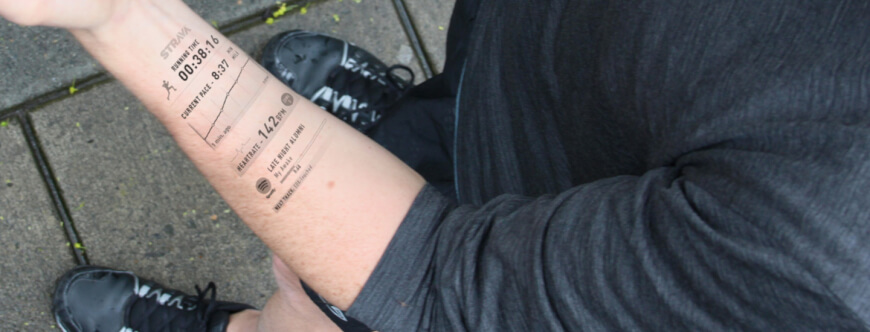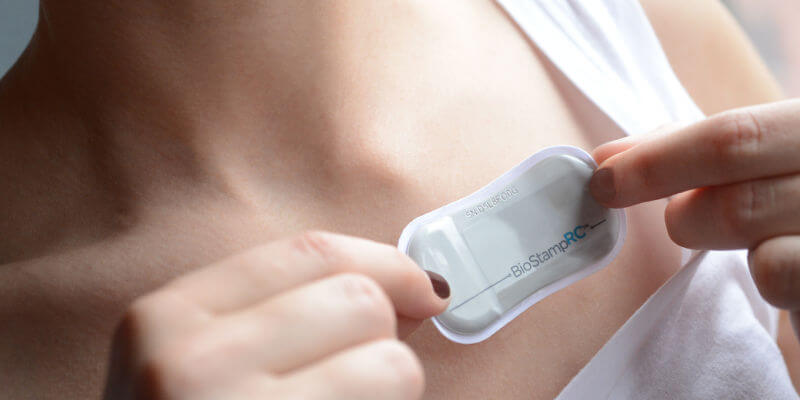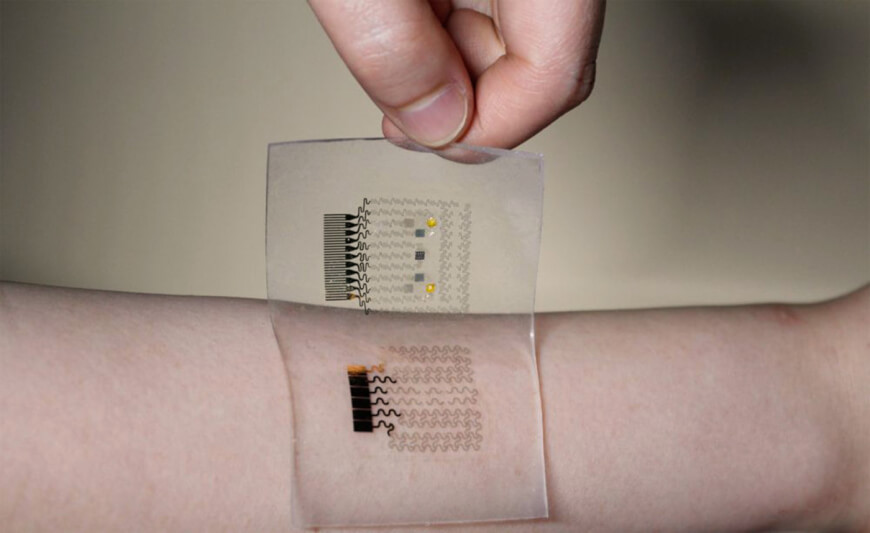The Medical Futurist | September 4, 2018
What if markings on your skin could unlock your phone or get you access to entrance doors? And what if they could also measure your blood pressure or hydration level constantly in the background only alerting you in case of values out of the normal range? Digital tattoos could act as minilabs rendering our skin an interactive display and making healthcare more invisible at the same time. Here’s our summary of the latest trends and research efforts to make it happen.
Our bodies are the next frontier for technology
In the course of the development of medical devices, a general trend has emerged: tools are getting more miniaturized, digitized and connected than ever. While in the past, the ultimate goal of medical instruments was to somehow measure health parameters or to somehow record measurements, currently, the question is how to measure more accurately, more easily and simply by using aptly designed means.
However, the triumphant march of health sensors and wearables does not stop at creating ever tinier, more and more streamlined smartwatches or clothing clips – such as the Lumo Run -, the next frontier for technological advancement definitely takes us the closest to the human body that we have ever been. Seamless, thin and unrecognizable sensors made of flexible materials appear first interwoven with our clothes, then on our skin as digital tattoos, in our bellies as digestibles or in our blood vessels as nanobots.
In sports medicine, there are already digitized garments for improving performance. For example, HexoSkin developed a shirt with sensors woven into it that measures heart rate, breathing, counts steps taken, pace, and calories burned. Moreover, researchers working in nanotechnology, are experimenting with exceptionally micro-sized – smaller than a millimeter – robots that literally swim through your bodily fluids; and the FDA approved the first digital pill with a digital ingestion tracking system in 2017. Now, let’s see how digital tattoos want to crawl onto our skins.
What do we call a digital tattoo?
With the development in 3D printing as well as circuit printing technologies, flexible electronics and materials, applying the so-called digital tattoos or electronic tattoos on the skin for some days or even weeks became possible. Some researchers use gold nanorods, others graphine or various polymers with rubber backing to apply the tattoo on the skin without causing irritation. Certain experts believe that these skin patches or tattoos are only the beginning, and in the future, other skin techniques such as henna, tanning, and makeup will also be tested.
These flexible, waterproof materials impervious to stretching and twisting coupled with tiny electrodes are able to record and transmit information about the wearer to smartphones or other connected devices. That’s why phantasies about digital tattoos unlocking tablets, opening doors or supporting border crossing took off. In 2014, Motorola Corporation launched the digital tattoo for identification of its Moto X handset. The digital tattoo sticker unlocks the smartphone without the need for any passwords or patterns.
As the tiny patches can measure electrophysiological parameters, they could allow healthcare experts to monitor and diagnose critical health conditions such as heart arrhythmia, heart activities of premature babies, sleep disorders and brain activities noninvasively. Moreover, by tracking vital signs 24 hours a day, without the need for a charger, it is especially suited for following patients with high risks of stroke, for example. The digital tattoo could send alerts to medical systems, it might call the ambulance and transmit pertinent data, too.
In the future, tiny multifaceted patches might as well track muscle movements around speech, when applied to the throat, potentially turning the tattoos into half of a wireless hands-free kit. Since you don’t actually have to speak out loud, it could pick up sub-vocal commands, too. Alternatively, the figurative or non-figurative, well-designed electronic tattoos can even track brain signals with enough accuracy to control a computer. However, that’s still the distant future. Anyhow, here are some projects and research efforts which already made digital tattoos happen.

The most advanced digital tattoos to date
1) MC10
The Cambridge, Massachusetts-based company has been the most well-known enterprise specialized in the advancement of digital tattoos for the last ten years. John Rogers and his research team gave the groundwork for the revolutionary technology in stretchable electronics, on which MC10’s operation is based. The company tirelessly develops silicon devices thinned to a fraction of the width of a human hair, uses stretchable metallic interconnects, and elastic rubberlike polymers to form complete powered systems that sense, measure, analyze, and communicate information.
In 2016, MC10 marketed its BioStampRC sensor, a waterproof, band-aid-like patch that sticks to the skin and monitors movement, muscle performance or heart activity. The tiny wearable even has a Bluetooth radio and a miniature battery.

2) Graphene-based electronic tattoo
A group of researchers based at the University of Texas created graphene-based, almost transparent tattoos and published their work last year. While researchers usually use gold in electronic components, here, they applied graphene – a more conductive, hundreds of times thinner material allowing to naturally wrinkle with the skin.
Due to graphene’s unique electronic properties, these patches work like wearable electronic devices, enabling biometric uses, such as monitoring the electrical activity of the brain, heart, and muscles. The tattoos would even allow the wearer to directly interact with machines. These tattoos offer complete functionality for several days but can be removed simply with a piece of adhesive tape. It is hoped that as the cost of graphene falls, such tattoos will become affordable for medical use.
3) Dermal Abyss
Researchers at Harvard and the Massachusetts Institute of Technology developed color-changing digital tattoos within the project entitled Dermal Abyss, a bunch of biosensitive inkschanging colors parallel how changes in your body occur. The inks can measure the concentration of glucose, sodium, and pH in the skin’s interstitial fluid, which surrounds cells.
The researchers have so far created a green ink that intensifies as the wearer’s sodium levels rise, which is often a sign of dehydration. Another green ink turns brown as glucose levels rise, which could be used by people with diabetes for monitoring their condition in the future. In early tests, pink inks turned blue as pH levels increased, but researchers are still testing various new inks for future use.
4) Glucose-monitoring temporary tattoos
Nanoengineers at the University of California, San Diego, have developed a temporary tattoo that both extracts and measures the level of glucose in the fluid in between skin cells. The flexible device consists of carefully patterned electrodes printed on temporary tattoo paper. The two electrodes apply a tiny amount of electrical current that forces glucose molecules that reside below the skin to rise to the surface, allowing for the measurement of blood sugar. In the spring of 2018, the research center started a clinical trial with 50 adults, ages 18 to 75, with either type 1 or 2 diabetes or diabetes due to other causes. They hope that one day the non-invasive, discrete and seamless digital tattoo can replace regular blood tests through finger pricks.
South Korean researchers have created something similar with the help of graphene. Seoul National University assistant professor Dae-Hyeong Kim and a team of researchers manufactured specific sensors that can detect your temperature and the pH/chemical composition of the sweat of people with e.g. type II diabetes. It then beams the data it collects to an accompanying smartphone app. If the system infers that the wearers need medicine based on the state of their sweat, the app computes for the amount of necessary medication. The patch’s microneedle array then injects the right amount into the body.

Digital tattoos will help make healthcare seamless and invisible
Can you imagine a dolphin-shaped digital tattoo measuring your heart rate on your ankle? And what about a glucose monitor forming a sailing boat on your belly? The Medical Futurist recommends you to get used to this thought as the latest trend in the health sensor and wearable market shows, that digital tattoos are the future. These seamless, thin and unrecognizable sensors could replace smartwatches or wrist-worn wearables as they won’t need batteries – they will get the necessary energy through electrophysiological processes -, and they will be more accurate due to constant skin contact.
It is an astonishingly hopeful phenomenon for shifting from reactive “sick care” to preventive as well as predictive health. These tiny digital tattoos could immediately signal if a measurement is out of range or significantly differs from the average – and the user or the doctor could promptly respond to it.
In other industries that work already. Isn’t it ridiculous and terrifying at the same time that we bring our cars to the car service at the moment that it indicates a problem, however, we don’t do that with our own signals? We don’t deal with them, or we don’t even know there was a sign. The Medical Futurist hopes that the beautifully designed digital tattoos will change the situation soon.

